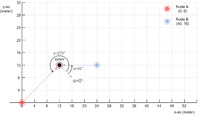Hello i am trying to make a localization system. Therefore i would try Triangulation to calculate the position of my unknown node.
For example see image:

I would like to calculate the x, y coordinate of the system knowing the angles of node A and B to the system and the x, y locations of node A and B.
Actually i though there were a lot of default formula's for this case, like there is for trilateration.
Do you guys have any clue how i can solve this ? Or is it even possible because i can barely find anything about it..
For example see image:

I would like to calculate the x, y coordinate of the system knowing the angles of node A and B to the system and the x, y locations of node A and B.
Actually i though there were a lot of default formula's for this case, like there is for trilateration.
Do you guys have any clue how i can solve this ? Or is it even possible because i can barely find anything about it..
